2012 PEUGEOT 4007 lock
[x] Cancel search: lockPage 94 of 236
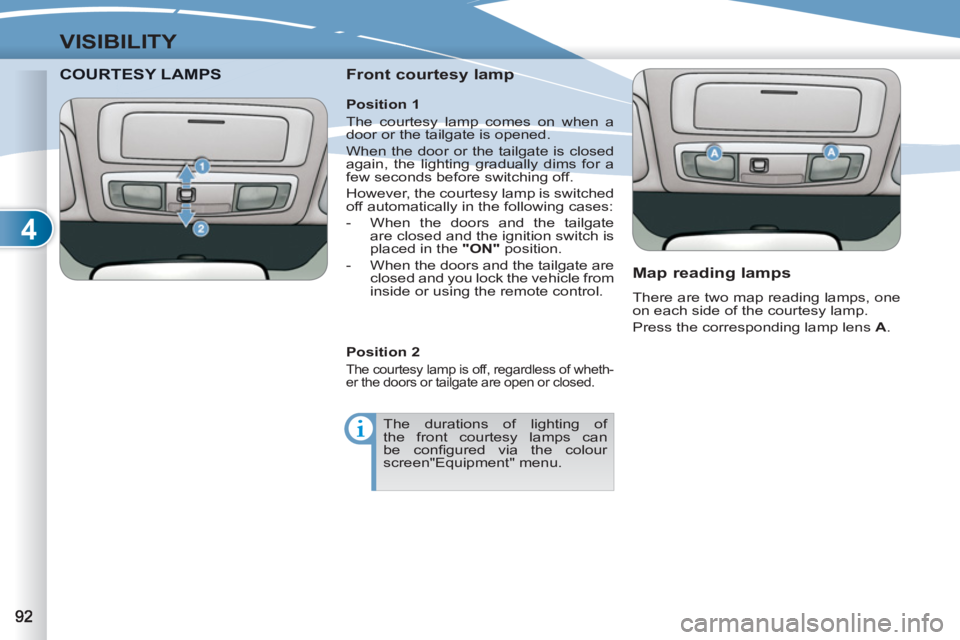
4
VISIBILITY
COURTESY LAMPTESY LAMPS
Front courtesy lamp
Map reading lamps
There are two map reading lamps, one
on each side of the courtesy lamp.
Press the corresponding lamp lens A
.
Position 2
The courtesy lamp is off, regardless of wheth-
er the doors or tailgate are open or closed.
The durations of lighting of
the front courtesy lamps can
be confi gured via the colour
screen"Equipment" menu.
Position 1
The courtesy lamp comes on when a
door or the tailgate is opened.
When the door or the tailgate is closed
again, the lighting gradually dims for a
few seconds before switching off.
However, the courtesy lamp is switched
off automatically in the following cases:
- When the doors and the tailgate
are closed and the ignition switch is
placed in the "ON"
position.
- When the doors and the tailgate are
closed and you lock the vehicle from
inside or using the remote control.
Page 95 of 236
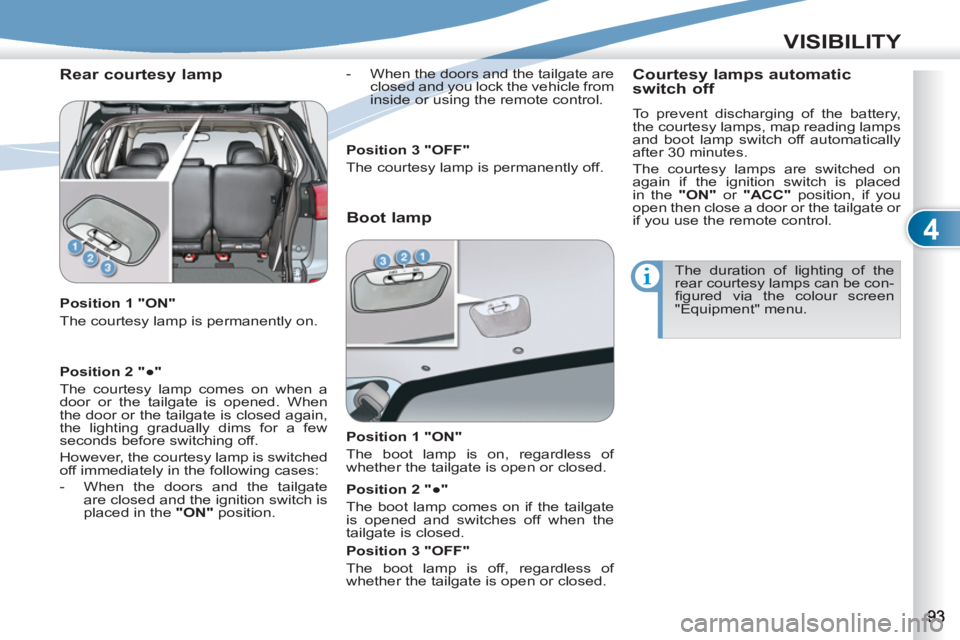
4
VISIBILITY
Rear courtesy lamp
Position 1 "ON"
The courtesy lamp is permanently on.
- When the doors and the tailgate are
closed and you lock the vehicle from
inside or using the remote control.
Boot lamp
Position 1 "ON"
The boot lamp is on, regardless of
whether the tailgate is open or closed.
Position 2 "●"
The courtesy lamp comes on when a
door or the tailgate is opened. When
the door or the tailgate is closed again,
the lighting gradually dims for a few
seconds before switching off.
However, the courtesy lamp is switched
off immediately in the following cases:
- When the doors and the tailgate
are closed and the ignition switch is
placed in the "ON"
position.
Position 3 "OFF"
The courtesy lamp is permanently off.
Position 2 "●"
The boot lamp comes on if the tailgate
is opened and switches off when the
tailgate is closed.
Position 3 "OFF"
The boot lamp is off, regardless of
whether the tailgate is open or closed.
Courtesy lamps automatic
switch off
To prevent discharging of the battery,
the courtesy lamps, map reading lamps
and boot lamp switch off automatically
after 30 minutes.
The courtesy lamps are switched on
again if the ignition switch is placed
in the "ON"
or "ACC"
position, if you
open then close a door or the tailgate or
if you use the remote control.
The duration of lighting of the
rear courtesy lamps can be con-
fi gured via the colour screen
"Equipment" menu.
Page 103 of 236
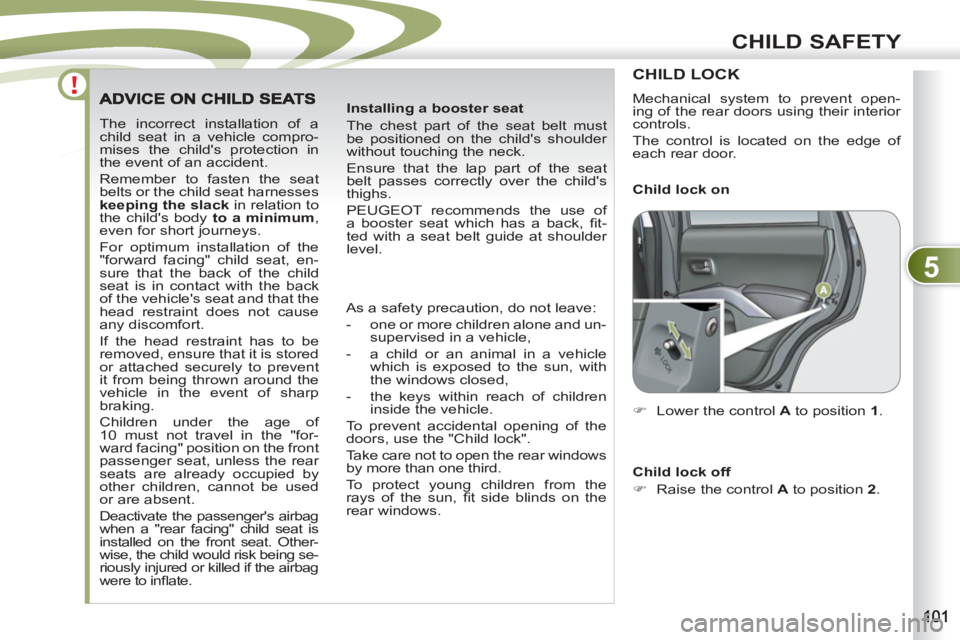
5
CHILD SAFETY
The incorrect installation of a
child seat in a vehicle compro-
mises the child's protection in
the event of an accident.
Remember to fasten the seat
belts or the child seat harnesses
keeping the slack
in relation to
the child's body to a minimum
,
even for short journeys.
For optimum installation of the
"forward facing" child seat, en-
sure that the back of the child
seat is in contact with the back
of the vehicle's seat and that the
head restraint does not cause
any discomfort.
If the head restraint has to be
removed, ensure that it is stored
or attached securely to prevent
it from being thrown around the
vehicle in the event of sharp
braking.
Children under the age of
10 must not travel in the "for-
ward facing" position on the front
passenger seat, unless the rear
seats are already occupied by
other children, cannot be used
or are absent.
Deactivate the passenger's airbag
when a "rear facing" child seat is
installed on the front seat. Other-
wise, the child would risk being se-
riously injured or killed if the airbag
were to infl ate.
Installing a booster seat
The chest part of the seat belt must
be positioned on the child's shoulder
without touching the neck.
Ensure that the lap part of the seat
belt passes correctly over the child's
thighs.
PEUGEOT recommends the use of
a booster seat which has a back, fi t-
ted with a seat belt guide at shoulder
level.
As a safety precaution, do not leave:
- one or more children alone and un-
supervised in a vehicle,
- a child or an animal in a vehicle
which is exposed to the sun, with
the windows closed,
- the keys within reach of children
inside the vehicle.
To prevent accidental opening of the
doors, use the "Child lock".
Take care not to open the rear windows
by more than one third.
To protect young children from the
rays of the sun, fi t side blinds on the
rear windows.
CHILD LOCK
�)
Lower the control A
to position 1
.
Child lock on
Child lock off
�)
Raise the control A
to position 2
.
Mechanical system to prevent open-
ing of the rear doors using their interior
controls.
The control is located on the edge of
each rear door.
Page 105 of 236
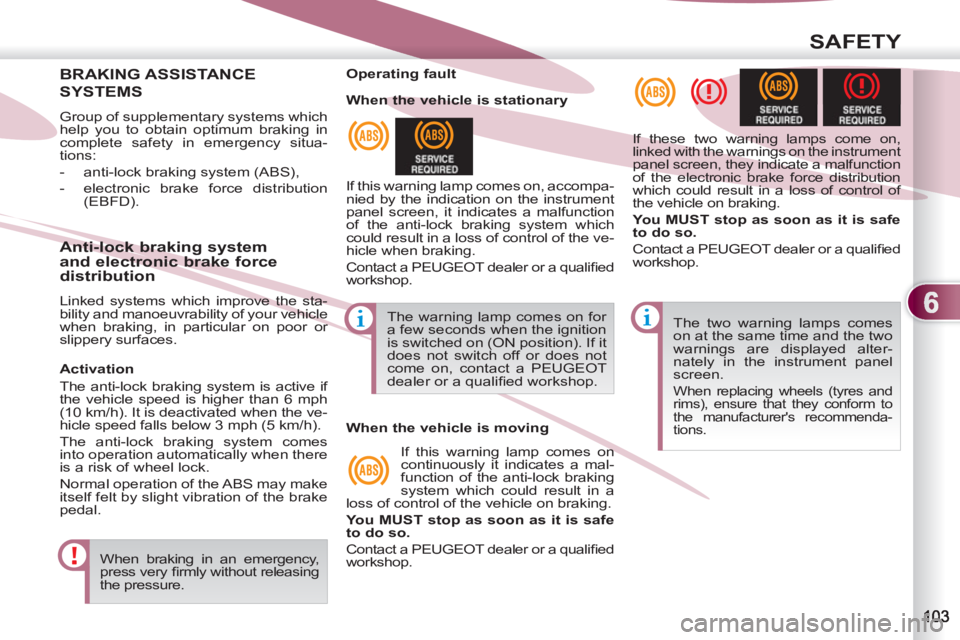
6
SAFETY
BRAKING ASSISTANCE
SYSTEMS
Group of supplementary systems which
help you to obtain optimum braking in
complete safety in emergency situa-
tions:
- anti-lock braking system (ABS),
- electronic brake force distribution
(EBFD).
When braking in an emergency,
press very fi rmly without releasing
the pressure. The two warning lamps comes
on at the same time and the two
warnings are displayed alter-
nately in the instrument panel
screen.
When replacing wheels (tyres and
rims), ensure that they conform to
the manufacturer's recommenda-
tions.
Operating fault
If this warning lamp comes on, accompa-
nied by the indication on the instrument
panel screen, it indicates a malfunction
of the anti-lock braking system which
could result in a loss of control of the ve-
hicle when braking.
Contact a PEUGEOT dealer or a qualifi ed
workshop. If these two warning lamps come on,
linked with the warnings on the instrument
panel screen, they indicate a malfunction
of the electronic brake force distribution
which could result in a loss of control of
the vehicle on braking.
You MUST stop as soon as it is safe
to do so.
Contact a PEUGEOT dealer or a qualifi ed
workshop.
Anti-lock braking system
and electronic brake force
distribution
Linked systems which improve the sta-
bility and manoeuvrability of your vehicle
when braking, in particular on poor or
slippery surfaces. The warning lamp comes on for
a few seconds when the ignition
is switched on (ON position). If it
does not switch off or does not
come on, contact a PEUGEOT
dealer or a qualifi ed workshop.
When the vehicle is stationary
When the vehicle is moving
If this warning lamp comes on
continuously it indicates a mal-
function of the anti-lock braking
system which could result in a
loss of control of the vehicle on braking.
You MUST stop as soon as it is safe
to do so.
Contact a PEUGEOT dealer or a qualifi ed
workshop.
Activation
The anti-lock braking system is active if
the vehicle speed is higher than 6 mph
(10 km/h). It is deactivated when the ve-
hicle speed falls below 3 mph (5 km/h).
The anti-lock braking system comes
into operation automatically when there
is a risk of wheel lock.
Normal operation of the ABS may make
itself felt by slight vibration of the brake
pedal.
Page 109 of 236
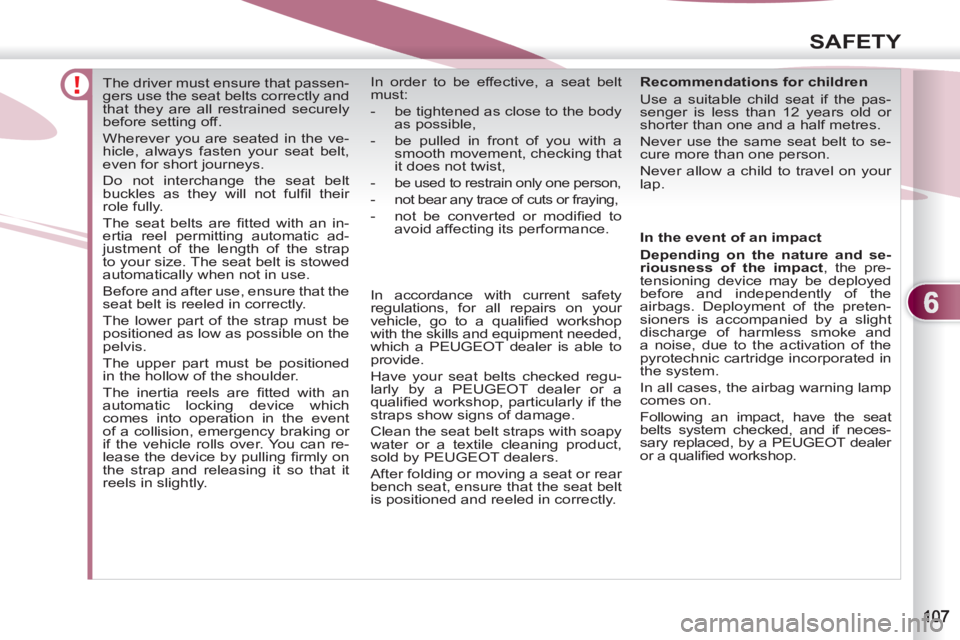
6
SAFETY
The driver must ensure that passen-
gers use the seat belts correctly and
that they are all restrained securely
before setting off.
Wherever you are seated in the ve-
hicle, always fasten your seat belt,
even for short journeys.
Do not interchange the seat belt
buckles as they will not fulfi l their
role fully.
The seat belts are fi tted with an in-
ertia reel permitting automatic ad-
justment of the length of the strap
to your size. The seat belt is stowed
automatically when not in use.
Before and after use, ensure that the
seat belt is reeled in correctly.
The lower part of the strap must be
positioned as low as possible on the
pelvis.
The upper part must be positioned
in the hollow of the shoulder.
The inertia reels are fi tted with an
automatic locking device which
comes into operation in the event
of a collision, emergency braking or
if the vehicle rolls over. You can re-
lease the device by pulling fi rmly on
the strap and releasing it so that it
reels in slightly.
Recommendations for children
Use a suitable child seat if the pas-
senger is less than 12 years old or
shorter than one and a half metres.
Never use the same seat belt to se-
cure more than one person.
Never allow a child to travel on your
lap. In order to be effective, a seat belt
must:
- be tightened as close to the body
as possible,
- be pulled in front of you with a
smooth movement, checking that
it does not twist,
-
be used to restrain only one person,
- not bear any trace of cuts or fraying,
- not be converted or modifi ed to
avoid affecting its performance.
In accordance with current safety
regulations, for all repairs on your
vehicle, go to a qualifi ed workshop
with the skills and equipment needed,
which a PEUGEOT dealer is able to
provide.
Have your seat belts checked regu-
larly by a PEUGEOT dealer or a
qualifi ed workshop, particularly if the
straps show signs of damage.
Clean the seat belt straps with soapy
water or a textile cleaning product,
sold by PEUGEOT dealers.
After folding or moving a seat or rear
bench seat, ensure that the seat belt
is positioned and reeled in correctly.
In the event of an impact
Depending on the nature and se-
riousness of the impact
, the pre-
tensioning device may be deployed
before and independently of the
airbags. Deployment of the preten-
sioners is accompanied by a slight
discharge of harmless smoke and
a noise, due to the activation of the
pyrotechnic cartridge incorporated in
the system.
In all cases, the airbag warning lamp
comes on.
Following an impact, have the seat
belts system checked, and if neces-
sary replaced, by a PEUGEOT dealer
or a qualifi ed workshop.
Page 121 of 236

7
DRIVING
FOUR WHEEL DRIVE SYSTEMFOUR WH
WITH ELECTRONIC CONTROL WITH E
4WD AUTO (position 1)
The vehicle operates with four wheel
drive and provides optimum traction re-
gardless of the level of grip.
This is the vehicle's normal and regular
operating mode, the distribution of the
torque between the front and rear axles
is controlled automatically.
The distribution favours the front wheels,
the transfer of torque to the rear wheels
is managed electronically by the control
unit in relation to the level of grip, so
providing optimum road holding.
Three transmission modes are avail-
able and can be selected manually by
the driver in accordance with his re-
quirements.
You can change transmission mode
when stationary or while driving at a
speed below 60 mph (100 km/h)
.
The transmission mode can be selected
by turning the control A
.
Display in the instrument panel
The transmission mode is displayed
in the form of an intermittent display in
the instrument panel screen when the
transmission mode is selected.
Selecting the transmission
mode
The selection of this mode is
recommended when the level of
grip permits.
2WD (position 3)
The vehicle operates with front two
wheel drive.
This mode corresponds to use on a tar-
macked road on which the driver con-
siders that there is no risk of loss of grip
(dry road).
4WD LOCK (position 2)
The vehicle operates with four wheel
drive in this mode also.
It is recommended when grip is particularly
poor or diffi cult (sand, mud, slopes, ...). System which permits the selection of
a transmission mode in relation to the
driving conditions.
Page 122 of 236

7
DRIVING
Operating faults
If the selected transmission mode display
fl ashes, the vehicle switches automati-
cally to front "2WD"
transmission mode.
It is then no longer possible to select the
transmission mode using the control A
. Do not subject the vehicle to ex-
cessive conditions while driving.
As the engine torque is applied
to all four wheels, the condition
of the tyres has a considerable
impact on the performance of
the vehicle.
Ensure that all four tyres are in
good condition.
Avoid driving the vehicle in
sandy or muddy areas or in
other areas in which the wheels
could spin.
Spinning the wheels places the
transmission components under
pressure and could cause a seri-
ous malfunction.
Do not drive the vehicle through
deep water.
Avoid driving over excessively
uneven terrain (risk of scraping
under the body or of grounding
on crossing a bridge).
Have your vehicle towed on a
fl atbed.
The vehicle must not be towed
with the front or rear wheels on
the ground even if it is in front
"2WD" (2 wheel drive) mode.
If the message "SLOW DOWN" is dis-
played on the instrument panel, let the
transmission cool down then wait for the
display to clear before setting off again.
If "4WD" and "LOCK" are displayed
alternately and if "MAINTENANCE
REQUIRED" is displayed in the instru-
ment panel, the system has failed and
the safety system has been activated.
Contact a PEUGEOT dealer or a quali-
fi ed workshop without delay.
Page 137 of 236
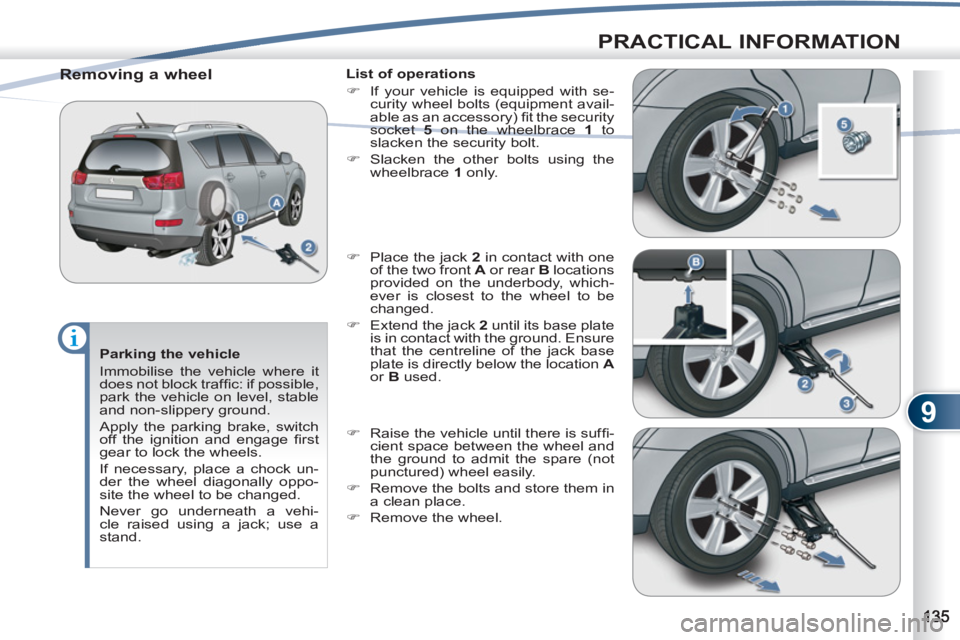
9
PRACTICAL INFORMATION
Parking the vehicle
Immobilise the vehicle where it
does not block traffi c: if possible,
park the vehicle on level, stable
and non-slippery ground.
Apply the parking brake, switch
off the ignition and engage fi rst
gear to lock the wheels.
If necessary, place a chock un-
der the wheel diagonally oppo-
site the wheel to be changed.
Never go underneath a vehi-
cle raised using a jack; use a
stand.
Removing a wheel
List of operations
�)
If your vehicle is equipped with se-
curity wheel bolts (equipment avail-
able as an accessory) fi t the security
socket 5 on the wheelbrace 1
to
slacken the security bolt.
�)
Slacken the other bolts using the
wheelbrace 1
only.
�)
Place the jack 2
in contact with one
of the two front A
or rear B
locations
provided on the underbody, which-
ever is closest to the wheel to be
changed.
�)
Extend the jack 2
until its base plate
is in contact with the ground. Ensure
that the centreline of the jack base
plate is directly below the location A
or B
used.
�)
Raise the vehicle until there is suffi -
cient space between the wheel and
the ground to admit the spare (not
punctured) wheel easily.
�)
Remove the bolts and store them in
a clean place.
�)
Remove the wheel.